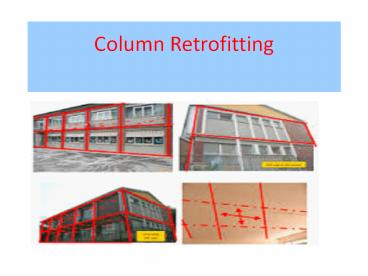Column Retrofitting 3 july 17 - PowerPoint PPT Presentation
Title:
Column Retrofitting 3 july 17
Description:
Structural and Non-Structural Retrofitting of Existing Buildings and Facilities and EHP Review FEMA’s Hazard Mitigation Assistance (HMA – PowerPoint PPT presentation
Number of Views:33
Title: Column Retrofitting 3 july 17
1
Column Retrofitting
2
Description
- Structural and Non-Structural Retrofitting of
Existing Buildings and Facilities and EHP Review
FEMAs Hazard Mitigation Assistance (HMA) and
Public Assistance (PA) programs provide funds to
eligible applicants for structural and
non-structural retrofitting of existing
buildings. PAs Section 406 Hazard Mitigation and
HMAs Section 404 Hazard Mitigation Grant Program
(HMGP) funds are available only following a
Presidential major disaster declaration.
Retrofits are primarily defined as modifications
to the elements of a building to reduce or
eliminate the risk of future damage. Structural
retrofits are designed to protect elements such
as foundations, load-bearing walls, beams,
columns, building envelopes, windows, structural
floors, roofs, and the connections between these
elements. Non-structural retrofitting involves
the modification of a building or facilitys
non-structural elements and may include bracing
building contents to prevent earthquake damage or
elevation of heating and ventilation systems to
minimize or prevet flood damage.
3
- Timeframes for EHP Review Timeframes for EHP
review vary depending on a projects potential
impacts and complexity. For projects that do not
affect historic properties (which are defined as
buildings, sites, or districts listed in or
eligible for the NRHP), the review process
generally takes 30 days after FEMA has received a
complete project application with supporting
documentation. If FEMA determines that the
proposed retrofit will have an adverse effect on
historic properties, FEMA is required to consult
with the State Historic Preservation Office
(SHPO), the Advisory Council on Historic
Preservation, and other interested parties to
develop a Memorandum of Agreement (MOA) in order
to resolve adverse effects under Section 106 of
the NHPA. Development of this MOA will generally
extend the review period a minimum of 60 to 90
days as it involves outside resource agencies and
other stakeholders.
4
- EHP Best Practice Pasadena, CA City Hall Seismic
Retrofitting - Seismic retrofitting of historic buildings
requires balancing design constraints, costs, and
safety issues with Federal compliance
requirements. In 2007, the City of Pasadena
completed an 80 million seismic
retrofit/restoration of their historic city hall,
built in 1927, that avoided adverse effects under
Section 106 of the NHPA even though the 170,000
square-foot building had been separated from the
ground with 240 rubber structures in a rare
earthquake-proofing process known as base
isolation. In order to offset construction costs,
the City pursued all grant opportunities,
including HMGP funding. This award-winning
project demonstrated how successful planning and
coordination can effectively balance seismic
safety, Federal historic compliance, and historic
preservation goals. It illustrates the importance
of working closely with the SHPO and other
interested stakeholders, utilizing knowledgeable
engineers, and leveraging funding that
specifically supports the retrofit of a historic
building
5
Thank You
- Read more Column Retrofitting
- Log on to nvlnconstructions.com































